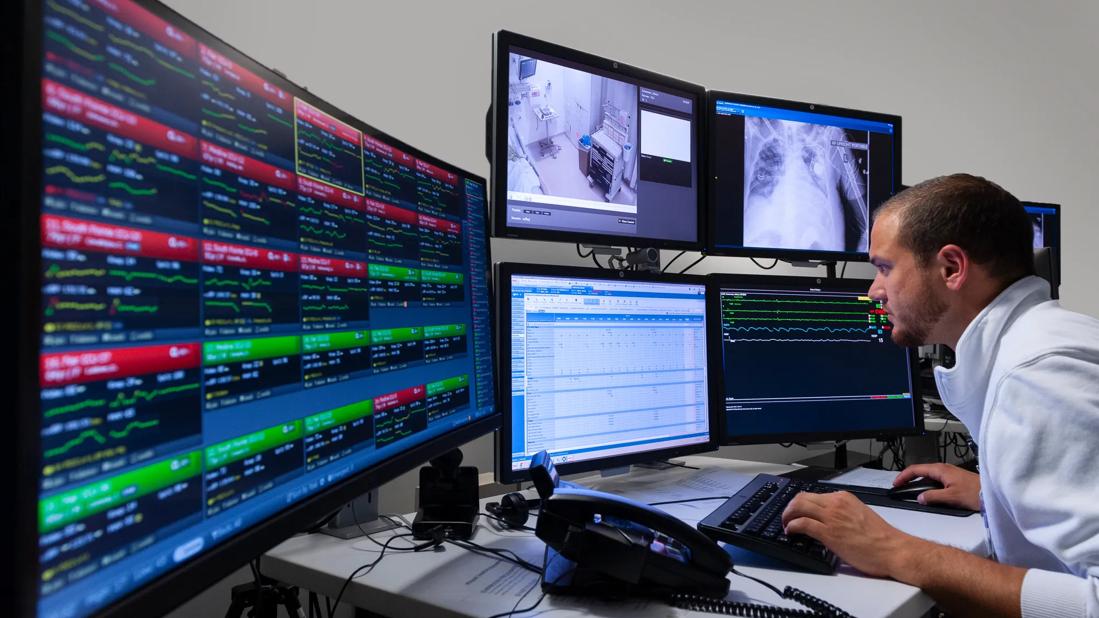While logistical questions remain about RPM, its benefits for both patients and caregivers are abundantly clear

Written by Jonathan McCulley and Jason Turowski, MD
Advertisement
Cleveland Clinic is a non-profit academic medical center. Advertising on our site helps support our mission. We do not endorse non-Cleveland Clinic products or services. Policy
Technology impacts virtually every aspect of our lives. As a healthcare organization, we have sought to leverage this ever-changing landscape to better the care we provide to our patients.
One such area identified for potential success is the advancement of Remote Patient Monitoring (RPM).
At its core, RPM is the ability of a patient to keep track of specific clinical parameters abroad with the ability to share the collected data with a provider in some capacity. The most typical setup is through a small medical device (spirometer, glucose monitor, etc.) linked to the patient’s smartphone. Ideally, this process should be “fully integrated” meaning that data is able to be sent from device to smartphone to medical record. This allows the provider to assess results quickly and with the least delay possible.
The real advantages of RPM are concentrated around bridging the gap in patient care among both acute and chronic states of disease. During an acute recovery, RPM is helpful in monitoring a patient’s condition immediately following discharge. This a particularly vulnerable period when changes in a patient’s vital signs may be indicative of complications to a hospital admission that cannot be otherwise known during the patient’s length of stay.
On the other hand, RPM can also benefit those who are dealing with a chronic condition. Often, changes to a patient’s vital signs or other bio-parameters in this setting can be insidious and slow in their development. Alterations can become significant in magnitude before a patient finally reaches out to a provider for help. Daily monitoring can detect changes over time, leading to early detection and intervention before the severity requires higher levels of care such as ER visits or hospital admissions.
Advertisement
RPM at Cleveland Clinic’s Respiratory Institute takes advantage of best practices gained from our experience during the COVID-19 pandemic. Our providers had no choice but to adapt to a healthcare model reliant on social distancing in which we pivoted from packed waiting rooms to carefully orchestrated virtual waiting queues. At that same time, projects focused on remote monitoring of pulmonary function in obstructive pulmonary diseases like asthma and emphysema as well as in interstitial lung diseases like IPF have been piloted as a means of improving connectivity between patients and their teams.
There is also interest in developing actigraphy to track, monitor and improve patient conditioning among cohorts of patients whose clinical decline could herald a downward trajectory. Wearable devices, including the ubiquitous Apple Watch, can collect patient data from pulse (and arrhythmias), to oximetry, nocturnal sleep habits, ovulation cycles and potentially blood pressure in future models.
Currently, the most active area of RPM utilization is via the Lung Transplant program. A remote spirometer collects data on patients’ lung function. The patient performs a specific respiratory maneuver several times a day, and this information is integrated with the medical record. In addition, alerts are sent out daily to the transplant coordinators when there are signs of possible clinical deterioration or issues with data collection adherence.
In addition to Lung Transplant, research projects around the area of cystic fibrosis and COVID-19 have also incorporated RPM into their protocols to assess effectiveness in monitoring a patient’s condition over time. There has also been interest in future projects regarding other pathologies such as COPD, Pulmonary Hypertension and Interventional Pulmonology.
Advertisement
Patients with complex medical regimens outside of our office purview can utilize exceptionally reliable wearables and share that data through their MyChart portals. This provides care to their caregivers with continuous monitoring opportunities. These advancements can prompt meaningful change in health conditions when objective and subjective measures can be discussed between patient and caregiver via a virtual face-to-face encounter.
One of the biggest impasses to widespread adoption of RPM is related to reimbursement of services. With RPM still in its relative infancy, there remains a significant gap in knowledge regarding clinical utility and how effective these services are at positively impacting patient outcomes. The next step is to work with regulatory bodies to identify knowledge gaps that impede reimbursement. This also speaks to the need to fully understand how new reimbursement codes — and which circumstances — they should be used to ensure our organization remains compliant.
Research will be another way to further our understanding of RPM and gain the critical knowledge that only experience can afford. This will allow us to refine processes and procedures as well as assess the limitations of this technology.
RPM adoption within the Institute, as well as across the healthcare industry, has been slow. Although the technology is new, we believe the benefits of RPM are clear. Our number one goal is to provide exceptional care, and RPM will undoubtedly be a part of that mission in the future. To what extent is the fundamental question.
Advertisement
Advertisement

Insights on bringing Cleveland Clinic even closer to becoming the best transplant enterprise in the world

Consensus statement aims to increase use of the perfusion technology and raise transplant volumes

Minimally invasive approach, peri- and postoperative protocols reduce risk and recovery time for these rare, magnanimous two-time donors

Minimally invasive pancreas-kidney replacement reduces patient’s pain, expedites recovery

Largest study to date confirms mortality rates similar to DBD transplant and reveals risk factors

Patient receives liver transplant and a new lease on life

More than 30% of patients die when early dialysis is needed after surgery

AHA recommendations for pretransplant evaluation, peritransplant and long-term management